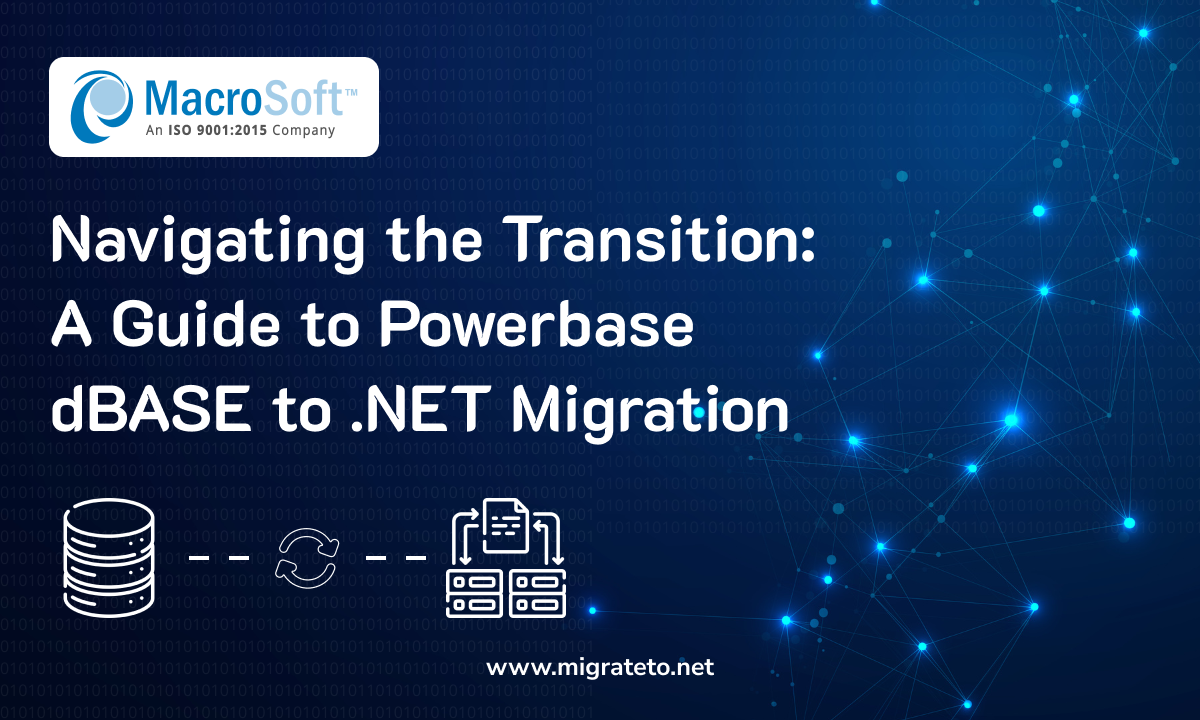By Joe Rafanelli | Published on February 28th, 2024 | Last updated on September 30th, 2024 |
For decades, Powerbase dBASE has served as a trusted companion for countless businesses, managing data and powering applications. But as technology relentlessly evolves, the limitations of dBASE become increasingly apparent. Scalability struggles, security vulnerabilities, and a shrinking development community hinder growth and innovation. Embracing the modern landscape necessitates a bold step: migration to the .NET framework.
This guide transcends a mere roadmap, offering a comprehensive exploration of the dBASE to .NET migration journey. We’ll delve into the “whys” and “hows,” equipping you with the knowledge and resources to navigate this transition with confidence.
The Compelling Case for dBase Migration:
While nostalgia may tug at your heartstrings, the numbers speak for themselves:
- Limited Scalability: According to a recent IDC report, 80% of businesses struggle with data growth, and dBASE’s limitations can stifle this expansion.
- Security Vulnerabilities: A Ponemon Institute study reveals that data breaches cost businesses an average of $4.24 million, and outdated technology like dBASE increases this risk.
- Shrinking Development Community: Finding qualified dBASE developers is increasingly challenging, as reported by TechCrunch. This hinders maintenance, innovation, and agility.
Migrating dBase to .NET provides a powerful antidote:
- Enhanced Scalability: .NET comfortably handles large datasets, supporting growth and enabling advanced analytics, as evidenced by Microsoft’s Azure success stories.
- Improved Security: .NET’s robust security features, highlighted by Gartner, mitigate vulnerabilities, protecting your valuable data.
- Vibrant Developer Community: With millions of active developers, according to .NET Foundation data, .NET ensures ongoing support and innovation.
Planning Your Migration Odyssey:
The dBASE to .NET transition is no simple voyage. A well-defined plan is your compass, guiding you through uncharted waters. Here’s your navigational chart:
1. Comprehensive Assessment (Charting Your Course):
- Application Inventory: Meticulously map your existing dBASE applications, identifying functionalities, data dependencies, and user base.
- Migration Goals: Define your objectives. Do you seek a complete rewrite, or a phased approach focused on specific applications? Establish success metrics.
- Resource Evaluation: Assess your budget, timeline, and technical expertise. Consider partnering with experienced migration consultants for expert guidance.
2. Data Migration (Crossing the Rubicon):
- Strategy Selection: Choose a data migration approach that aligns with your needs. Direct conversion, staged migration, or a hybrid approach are viable options.
- Tool Selection: Leverage powerful data migration tools like Imigration Software’s dBASE to SQL Server Migration Tool or Devart’s dbForge Data Migration to streamline the process and ensure data accuracy.
- Testing and Validation: Rigorous testing is crucial. Verify the correctness and functionality of migrated data through thorough testing cycles.
3. Application Development (Building Your New Home):
- Development Approach: Decide whether to rewrite applications from scratch or utilize .NET migration frameworks like dbForge NET Generator or Visual DBF.
- Modernization Embrace: Leverage .NET’s rich ecosystem of libraries and frameworks like ASP.NET MVC, Entity Framework, and SQL Server to build modern, scalable applications.
- Cloud Consideration: Explore cloud-based solutions like Azure for enhanced scalability, agility, and cost-effectiveness.
4. Testing and Deployment (Setting Sail):
- Rigorous Testing: Perform comprehensive testing to ensure all functionalities work seamlessly in the new .NET environment.
- Phased Deployment: Consider a phased rollout to minimize disruptions and user impact. Start with pilot applications or departments and gradually expand.
- Training and Support: Provide adequate training and ongoing support to users during the transition to ensure smooth adoption and minimize resistance.
Beyond the Horizon: Essential Considerations:
- Seek Expert Guidance: Partner with experienced migration consultants like Imigration Software or Devart to navigate complexities and ensure a smooth transition. Their expertise and proven methodologies can save you time, resources, and headaches.
- Future-Proofing: Design your migration with future scalability and growth in mind. Utilize cloud-based solutions and modular architectures for adaptability. Consider containerization and microservices for further flexibility and resilience.
- Staying Informed: Keep updated on the latest .NET technologies and best practices through resources like Microsoft’s documentation and industry publications, attend webinars, conferences, and online communities to stay ahead of the curve.
Embracing the Journey:
Migrating from dBASE to .NET is a transformative journey, not just a destination. By carefully planning, choosing the right tools and partners, and staying informed, you can navigate this transition successfully and unlock the power of .NET for your business. Remember, the key is to embrace the possibilities, prioritize the future, and embark on this voyage with confidence.
Ready to chart your course towards a modern, scalable future? Macrosoft’s experienced migration consultants are seasoned captains, guiding you through the dBASE to .NET transition with expertise and precision. We leverage proven methodologies, cutting-edge tools, and in-depth .NET knowledge to ensure a smooth and efficient journey. From comprehensive assessments and data migration to modern application development and phased deployments, we’ll be your trusted partner every step of the way. Don’t let dBASE limitations hold you back. Contact Macrosoft today and unlock the boundless potential of .NET with our expert navigation!
Joe Rafanelli is the Director of Migration Services at Macrosoft. In this capacity, Joe acts as the single point of contact for Macrosoft’s migration solutions. Additionally, he collaborates with internal technology analysts to understand requirements, work scope, and maintain client relationships ensuring their satisfaction .
Prior to joining Macrosoft in May 2017, Joe had a resplendent career in the Banking Industry spanning 25 years. He focused on Account Management, Project Management, Implementation Management, and Product Development for companies like JPMorgan, Citigroup and Brown Brother Harriman.
Joe is excellent at improving the client experience by driving change management projects to completion. Joe has B.S. Finance, MBA Investment Finance, Project Management certificate & Database Management certificate.
